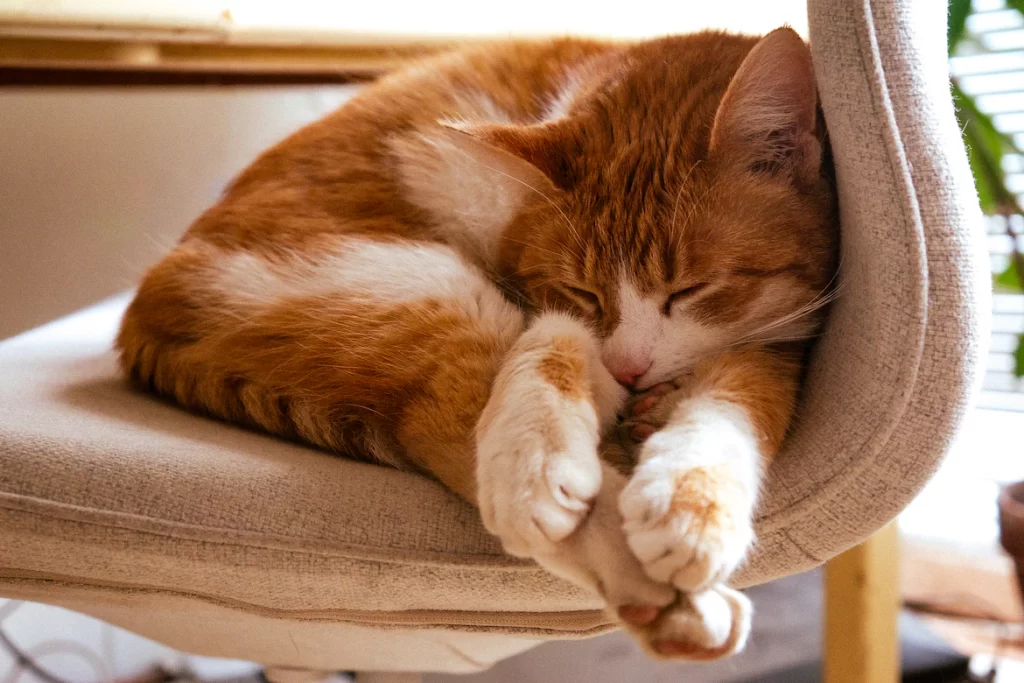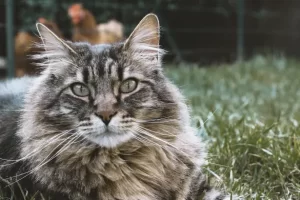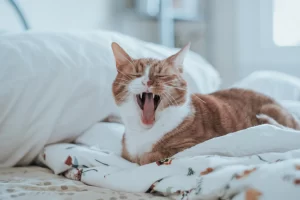Last updated on January 9th, 2023 at 03:21 am

Cats have strange sleeping patterns, and you may discover that your cat sleeps in unusual postures. When cats sleep, they frequently curl up into tight tiny balls, and you may wonder if and how that position can possibly be comfortable. While some cats are experts at bending their bodies into bizarre shapes for naps, there’s something tempting about the typical curled-up resting position. So, the question is, why do cats curl up when they sleep?
The truth is that cats adopt this sleeping position for a variety of reasons, and your cat is probably quite comfortable even when she’s entirely curled up. You don’t need to be concerned if your cat sleeps in a ball. There is nothing wrong with her, and she is only doing what comes easily to her. In truth, most of your cat’s unusual sleeping patterns have rather rational explanations. In this article, I’ll help you understand everything you need to know about why cats usually curl up when sleeping.
Why Do Cats Curl Up When They Sleep?
Although we can never know for definite why cats or other animals sleep the way they do, experts believe they have a good idea why cats sleep in a ball. Sleeping in a ball is most likely the safest, coziest, and warmest position for your cat. Here are some of the best reasons why they do it.
Warmth
Cats sleep curled up because it keeps them warmer than lying flat. They expose less of their body’s surface area to the surrounding air. This means that less heat is wasted from the body. As a result, they remain warmer. It’s all about surface area and heat loss through the skin, even though the fur helps to limit heat loss to a minimum.
And, of course, when a body curls in on itself, the areas that would normally be exposed to the air come into contact with other sections of the body, which heats them up. Again, it’s a matter of not losing body temperature to the air and instead using it to warm other regions of the body. The warm ambient air temperature causes a cat to stretch out while napping. This is most likely to happen while they are sleeping inside a heated house or when they’re on your lap, absorbing heat from your body. Under these conditions, there is no reason to keep body heat. They may even want to get rid of it because it is too hot.
Safety
Sleep is necessary for survival, yet cats are most vulnerable when they are sleeping. They would be vulnerable to predator attacks in the wild since they are not prepared to protect themselves. While sleeping, a cat’s vulnerable regions, such as the face and important organs in the chest and abdomen, are protected by curling up into a ball.
The stomach of a cat is an extremely sensitive area, which is why cats normally dislike having their stomach rubbed or stroked. The stomach area is totally enveloped by the rest of the body when a cat curls up into a ball, protecting it from damage. Although the back and tail of a cat are exposed in this position, they are not as vulnerable as the rest of the cat’s body, which is covered by the curled-up ball.
Comfortable
Have you ever gazed at your cat cuddled up in a ball of fluff and wished you could sleep like that? One of the primary reasons your cat sleeps curled up in a ball is that it is a very comfortable and soothing position to sleep in. Cats, on average, sleep for 12 to 18 hours out of every 24 hours! You’d want to be as comfy as possible if you spent that much time sleeping! Cats, like people, have favorite sleeping postures, and some cats prefer to sleep curled up considerably more than others.
Practical
When cats curl up into a ball, their bodies become smaller and more compact, allowing them to fit into spaces that they would otherwise be unable to. We’ve all seen how cats can find comfort and sleep in the most unusual settings. Curling up into a ball to sleep is one method they can accomplish this. Cat beds are frequently circular, encouraging your cat to sleep curled up.
Relaxation
Cats curl up into a ball to help them relax and extend their spine. Cats are incredibly flexible, and their elastic spines allow them to rotate more than many other animals. Their backbones are flexibly linked and have elastic cushioning discs. Cats have limber spines that allow them to do elegant acrobatic feats and sprint extremely swiftly.
What Is the Scientific Reason Why Cats Curl Up While Sleeping?
When cats sleep, they have the urge to snuggle up. Cats sleep in trees or other high areas in the wild because they are vulnerable to predators. Curling up into a ball made them less vulnerable to a passing predator. Domesticated cats no longer confront the same predator threat, yet the desire to curl up when sleeping persists.
Cats instinctively try to make themselves as small and compact as possible when they curl up. This makes them feel safer and more secure, allowing them to relax and sleep well. So, the next time you see your cat curled up in a ball, remember that they are simply acting on instinct.
What Are Some of the Advantages of Cats Sleeping Curl Up?
Cats are amusing animals. They are frequently seen sleeping in unusual configurations, like as curled up in a ball. But what are the advantages of such behavior? According to research, cats who sleep curled up have lower heart rates and breathing rates than those who sleep in other positions. This implies that cats can fall into a deeper sleep stage, which promotes physical and mental well-being.
Furthermore, lying in a tight curl keeps cats warm by trapping their body heat. This is particularly crucial for kittens and elderly cats, who are more susceptible to chilly temperatures. So the next time you see your cat curled up in a ball, remember that they are sleeping well.
What If My Cat No Longer Curls Up Into A Ball When Sleeping?
If you’ve noticed that your cat no longer curls up into a ball while they sleep as they used to, it could be an indication that this location is no longer comfortable. Arthritis is a common cause of this, especially in senior cats.
You may also notice that your cat is less likely to leap up onto objects or walks more stiffly than it used to. They may adopt a different posture or exhibit other subtle symptoms resembling increased fatigue or a lack of appetite. There are various things that can be done to relieve arthritis pain, including prescribing anti-inflammatory medication, so take your cat to the veterinarian if you feel they are arthritic.
Conclusion
In summary, cats frequently sleep curled up in a ball for protection, warmth, and comfort. Cats frequently sleep in a curl-up position for all of these reasons, even if they are perfectly secure and at ease in their environment. So, there’s no reason to be concerned if your cat prefers to sleep in a ball. If you look closely, you may notice your cat sleeping in different positions, like on its side, back, or loaf. In your home, all of these poses express ease and relaxation.


